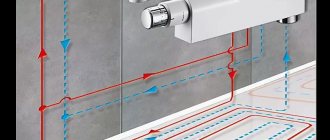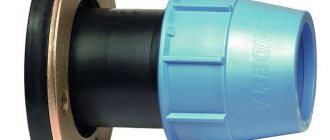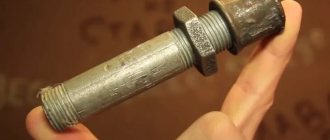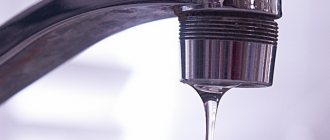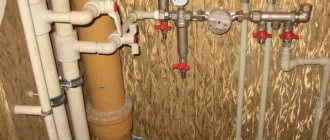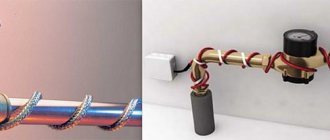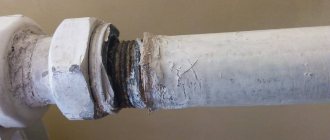A variety of ways to seal a fistula
To properly deal with the problem, first of all, you need to understand what a fistula in a pipeline is. This is the hole in the pipe through which water flows out.
You can eliminate it in several ways:
- using a bolt;
- using a temporary bandage;
- using an adhesive bandage;
- cold welding method.
But at the same time, it is imperative to drain the water from the system by closing the valves and opening all available taps.
What is a fistula?
A fistula is damage to the pipeline wall in the form of a crack or through hole. Leaks of this nature indicate that it is time to replace a section of pipe. However, it is not always possible to do this immediately after detecting a leak on your own. By the time the called technician arrives, a significant part of the apartment will be flooded with water, not only yours, but also your neighbor’s. But installing a temporary patch is not that difficult.
Repair using a temporary bandage
This method is used when the fistula in the pipeline has an oblong, elongated appearance.
A bandage is applied to the hole using sealing gaskets, which can be made from the following products:
- medical tourniquet;
- thick glove;
- bicycle tire;
- boot top, etc.
The main thing is that the size of the rubber gasket is significantly larger than the size of the hole. To fix the bandage on the pipeline, clamps or bolts are used.
Leak location in the pipe
In the heating system (not to be confused with the hot water pipeline for the tap), coolant leaks are possible in the following three areas:
1. On the straight part of the pipe in case of an undetected defect when purchasing the product. 2. In the area where pipes connect to each other and to the heating device. The reason for a possible leak when connecting polypropylene pipes to batteries is the use of a connecting element such as an American one, one end of which is made in the form of a thread; without sealing it, a breakthrough is possible. 3. In the area where battery sections are connected to each other.
Thus, a leak can form not only in steel heating systems as a result of iron oxidation, but also in stainless polypropylene parts. In pipes of various materials, there may be leakage in areas of high resistance to the coolant, turns, joints, etc., which increases pressure and reduces the flow rate of hot water for heating or steam, which causes mechanical stress on the pipe and reduces its wear resistance in such areas.
Sealing with adhesive bandage
Elimination of a fistula using this method is carried out in stages:
- Use a metal brush to clean the pipeline from dirt, treat its surface with acetone or gasoline and allow it to dry for 15 minutes.
- Tapes are cut from fiberglass, the length of which depends on the diameter of the pipe - it is necessary that the winding has at least 6 layers. The width of the material must exceed the cross-section of the pipeline by no less than one third.
- BF-2 glue is applied to the edges of the tape, then one side of it is covered with an epoxy adhesive with a spatula.
- The tool is pressed firmly against the fiberglass so that it is well saturated with glue.
- Then the tape is tightly wound onto a previously prepared surface so that its center covers the problem area.
- The bandage is secured with metal tape.
- After 24 hours, the repaired pipeline can be used.
If the system is laid in an unheated room where the temperature does not exceed 17 degrees, the pipeline can be used only after 4 days.
Tools and materials
In order to eliminate a fistula, you need to stock up on the following tools and materials:
- Drill;
- Set of bolts;
- Special adhesive composition BV-2;
- Metal brush;
- Epoxy adhesive;
- Petrol;
- Tap;
- Acetone;
- Kern;
- Putty knife.
Caused by rust
Before eliminating the fistula, it is necessary to drain the water from the system. For this purpose, it is necessary to close the stop valve. Then all the taps open.
Cold welding method
Repair of water pipes without welding is carried out using a special composition:
- The hole is expanded with a drill.
- The surface of the pipeline is degreased and cleaned with acetone.
- When the pipe is dry, a product called “cold welding” is applied to it and wait until it hardens completely - this usually takes about 10 minutes.
When using cold welding or epoxy adhesive, you must use rubber gloves. If glue gets on the skin, it must be removed with cotton wool and acetone, and then washed with warm water and soap.
How to fix a leak in your home heating system
If the leak is strong and a simple clamp cannot be used to close it, the heating circuit with liquid will have to be turned off. It doesn’t matter where the leak is found - on a heating or water supply pipe - eliminating the leak will only be possible by turning off the water supply. A disconnected circuit gives scope for repairs: you can at the same time check the entire route and repair (replace) all suspicious areas.
Let's start with the simplest ways to fix a leak in a heating pipe:
Seal the gap or hole with a fabric (fiberglass) patch liberally coated with epoxy glue. The patches (there should be 2-3 of them) are cut twice as wide as the diameter of the pipe; the length should allow the pipe to be wrapped 5-7 times. The metal around the violation is cleaned with sandpaper, a file or a grinder, the area is well dried, and epoxy resin is applied to it. The fabric can be soaked with glue in advance, or you can coat it as you wind it onto the pipe - whichever is more convenient on the spot. The last fabric layer is not saturated with glue, and the end of the fabric is secured with cord or wire. Epoxy dries on a pipe in different ways: at a temperature of 20 0 C-25 0 C, a few hours are enough; at a temperature below 18 0 C, even a day is not enough.
If you have repaired a central heating pipe, then the system operates under higher pressure than individual heating, and when water is initially supplied to the circuit after the repair, a noticeable water hammer may occur, which can simply rip off the patch. Therefore, the supply valve should be opened slowly, tracking the area with the patch visually.
You can increase the strength of the patch by adding bronze or aluminum powder to the epoxy glue. If you were unable to buy powder, you can make it at home by grinding off the surface of any non-ferrous metal part with a small file or needle file. By adding such powder, you can make not 5-7 turns of fabric, but 2-3, and repairing such an area will become easier and faster.
Factory materials
From ready-made solutions, adhesives and liquids, you can use a heat-resistant, waterproof sealant to seal the leak. Such adhesive compositions are produced specifically for the repair of heating systems. When purchasing, make sure that the word “neutral” is on the label - this means that your glue will not corrode non-ferrous metal and adjacent materials.
Cold welding is also good for eliminating leaks:
- A liquid epoxy substance that is convenient for impregnating fabric patches that are applied to a hole in a water pipe. Some compounds can also work on a wet surface;
- Semi-solid plastic compositions. This cold welding looks like a small piece of plasticine consisting of two different component strips. Knead the plasticine in your hands until the substance becomes plastic (your palms should be wet - moisten them in water), cover the hole in the pipe with a small piece, and spread it over the cleaned surface. It takes 10-15 minutes to harden, after which the patch becomes so hard that it is difficult to take even with a file.
Both liquid and solid cold welding contain toxins, so it is recommended to use rubber gloves when working with it.
Sealing connections on pipes and between radiator sections
If connections at the junction of pipes or fittings are leaking, then, depending on the difference in diameters, you can immediately seal the pipeline with a metal clamp or first wrap rubber in place with a smaller diameter. The rubber band is easily wound even under pressure, stopping severe leakage.
Flowing in the middle of the pipe
You need to inspect everything and identify the location of the damage. What to do if the hole is small and water is flowing, but there is no way to call a plumber? You can use Titanium White automotive putty and fill the hole with it.
This repair method will extend the life of the pipe by several years, but only if it does not supply water under high pressure.
If the leak is significant, then a layer of rubber, the so-called bandage, is placed in place of the gap, which should be larger in size than the hole.
The patch is fixed using soft wire. All of the above items can be purchased at a hardware store.
Do not forget that this method can be repaired only for a temporary effect (until the arrival of a master who can properly fix everything).
Unreliable connecting seam
What to do if water flows at the junction of the pipe to the battery, tap or in the area of the threaded joint? In this case, eliminating the problem will be somewhat more complicated, since sometimes elements of different diameters are connected.
What to do in this case? You can seal the hole using a piece of thin rubber, which must be clamped with a special metal clamp.
This solution cannot be a 100% solution to the problem. The joint will have to be disassembled and thoroughly welded or glued.
Final repairs can only be made if the heating and water drainage systems are completely turned off. If in a private house this process can be done independently, then in an apartment it is recommended to entrust such work to a specialist.
If the house has autonomous heating, the owner must always have new couplings and spare connecting elements on hand so that in the event of an accident, the hole can be quickly repaired.
Leaking between battery sections - what to do?
A small hole from which water flows can be sealed using a regular self-tapping screw, which can be found in every home.
Naturally, such a solution will not be enough for a long time, but it will still help eliminate the damage that even a slight leak can cause.
Second way. It is recommended to wrap the problem area with a thick cloth soaked in sealant or an adhesive solution that is resistant to water (hypoxide glue).
When the fabric is dry, you can connect the battery to the system, but in order to seal it properly, you should still seek help from a plumber.
What to do if the cause of the accident was a surge in water pressure? First of all, you should take care of eliminating the internal problem.
The use of pipes of different cross-sectional sizes may result in water hammer, especially in the process of eliminating air pockets.
In what cases is heating system repair necessary?
In any case, major repairs of heating systems are carried out on warm spring or summer days before the start of the winter season.
If there have been iron pipes in the apartment for more than five years, you need to think about replacing them with reinforced polypropylene samples, without waiting for it to burst.
The latter do not undergo oxidation when interacting with water and withstand water hammer, which makes them more durable compared to iron ones. Often, when repairing heating system pipes, professionals recommend sealing holes with “cold welding”. This material is super durable and, after drying, reliably covers any leaks.
All of the above methods for repairing heating pipes are not bad, but they can only save for a while, so in order not to ask yourself the following question: “The heating pipe is leaking, what should I do?” – call a plumber who can correctly and reliably fix all problems associated with the operation of the heating system, so that later, when winter comes, you do not have to carry out expensive repairs and do not turn off the entire house from heating.
Features of hot water supply
A fistula in a hot water pipe appears more often than in other places. The place that is most susceptible to this phenomenon is the riser. The first signs of danger in such a system are rusty growths.
Video: how to fix a leak on the drain
Such a fistula in the pipeline can be repaired using a bolt or temporary bandage. In both the first and second cases, it is impossible to act under pressure. The water supply must be shut off before work can be done.
A small leak can be sealed under pressure using an adhesive bandage. The edges of fiberglass with BF-2 glue applied are applied to the damaged area (the tape is applied very tightly). At the end, the tape must be tightened with a metal plate. Such a section will be able to function under pressure only after 24 hours.
Also in this situation, you can seal the leak with “cold welding”. It is better not to do such work under pressure. The resulting hole is slightly enlarged using a drill, and the area is degreased.
When everything is dry, apply the compound to the leaking crack. It should freeze completely. This takes approximately ten minutes.
Fistulas in wells
If we consider the sources of water supply in private areas, wells can be called the most promising. Compared to wells, they contain water of higher quality. It practically does not require cleaning or additional filtration.
During operation, the well, pump and water-lifting pipelines vibrate. This leads to weakening of the joints on the water-lifting mains, and accordingly, leaks (fistulas) appear. This often ends in serious accidents.
